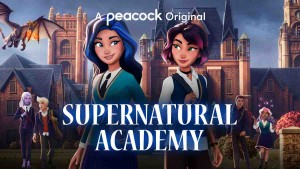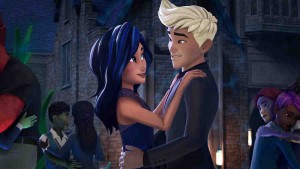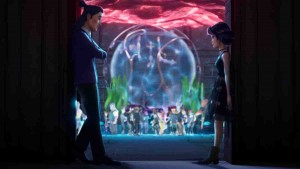SUPERNATURAL ACADEMY is now streaming the entirety of its first season on Peacock. Based on the bestselling novels by Jaymin Eve, the animated series produced by 41 Entertainment focuses on twin sisters Jessa and Mischa, as they navigate the magic-filled high school and a growing threat to the known world.
In Part 2 of our exclusive interview, show runner Gillian Horvath talks about the differences between writing for animation and live action, magical ethnicities, and more.
ASSIGNMENT X: Is SUPERNATURAL ACADEMY your first job writing for animation?
GILLIAN HORVATH: I’ve done one or two freelance animation scripts before, but in that case, someone else was supervising. So, to all intents and purposes, this was my first time writing animation, and that was absolutely a fascinating experience, to see what is similar in writing stories for animation and live-action, and what production realities you have to keep in mind that are different in the two formats.
AX: What are the differences?
HORVATH: One of my favorite things about doing the gig was, we specifically wanted to tell the stories in the format that I’m the most familiar with: hourlong, aimed at older teens and adults, science-fiction formatting in terms of the story progression. Julia Yorks and Kaaren Brown specifically have a lot of animation experience, so it was good to have them in the room when we were breaking story, to keep animation realities in mind.
I didn’t really interact directly with Steve Ball, the director. It’s very different from running a live-action show, because it’s separated that way. I did the head writing when we were writing the scripts. That was my purview, and we talked about production realities in terms of how it has to affect the story. But in terms of being hands-on with the records or the animation, that’s really not the role of a head writer in animation, so I wrote.
Some of the things were surprising. We knew going in that the advantage we have with animation is that you can have characters who are dragon shifters, and wolf shifters, and harpies with wings, and magic users with different-colored skin and brightly-colored hair, and a shifter with bunny ears, and none of those things have the kind of budgetary implications that they would have in live action.
In live action, if someone shifts into a wolf, you’re carefully counting how many shots that person can be a wolf in every episode, because you can only afford a certain amount of wolf CGI. But in animation, once you build the wolf, it’s no more expensive than a human being. It has the exact same cost. Any character, be they a dragon, or a harpy, or a human, has the same startup cost and the same usage cost. So, you have this wonderful freedom for them to be dragons and wolves whenever the story calls for it, and not be worried about, how can we just use our five shots, or ten shots, most effectively?
Some of the things are very similar [in live action and animation], in that you can have a certain number of locations, and then you need to find ways to reuse your existing locations, and you have a limit on how many extras you can have. The things that were surprising to me, that were different is, vehicles can be just as expensive as people or dragons. Having somebody drive a car is no big deal in live action, and can be a huge deal in animation.
We had this giant water scene where Mischa almost drowns. Water is one thing that is famously hard to do in animation. I talked to friends of mine who are animation show runners and head writers, and it was unanimous. Everyone said, “Water is really a problem. Characters interacting with water is the most expensive thing. Don’t do it.”
And then Kaaren Lee Brown, who was our creative producer on the show, and was there in the room – to write scripts, of course, but also to keep an eye on an awareness of animation production reality – is the one who wrote the episode with the big water scene where Mischa almost drowns. And so, the whole time, we were teasing her, like, “I thought we couldn’t have water.” But you can have it if it’s important enough.
Hilariously enough, it’s also difficult to do water in live action. Wet actors are expensive, multiple takes take time, and so more than once, when people were warning me that something was, “Oh, that’s going to be very difficult and expensive, you might not know, coming from live action,” I was like, “Oh, no, that’s difficult and expensive in live action, too.” For different reasons. But if it’s something the story requires, we’re going to pour our resources into it anyway.
Honestly, I think the animation technology is improving every day, every year. And so, something that used to be impossible then became difficult, and now it’s still moderately difficult, but in a couple of years, might be commonplace and not even an issue. I’m speaking outside my area of expertise now, but I do know for a fact that water looks better and is less difficult to achieve than it used to be.
In the party sequence, the Academy provides a tank so that the mermaids can dance, which we thought was nicely inclusive of them. But we had to specify that it was an enclosed tank, as opposed to some kind of a pool, because it’s splashing that’s difficult to do with water. The closed tank is no problem. The mermaids are inside it, it’s got a color change to indicate that it’s water. It’s the surface of water that is actually difficult to achieve, as I understand it.
And clothing changes are enormous. In live action, people wear a different outfit for every day of the storyline, and you can easily write into a script, “She grabs her jacket and pulls it on.” In animation, that is huge. People do not grab a jacket and pull it on. First of all, you’re not going to animate putting on the jacket; it’s much too complicated and not worth it. You could spend the same amount of time animating a fabulous, visually arresting sequence – why would you spend that time on just someone putting on their coat? But also, even if they put the coat on offscreen, it’s an expenditure, because the character with and without a jacket is practically a whole other build.
The Academy setting is to our advantage, because they have [school] uniforms, and they can wear them a lot. But before you even break the story, you’re thinking, “We have the version [of the character] in pajamas, we have the version in a uniform, we have a fancy dress for the party, we have casual clothes for New York, and that’s it.” And that’s a lot, honestly. The fact that we got four or five outfits for every character is more than some animated shows do, but it was important for the realism that we wanted. We wanted them to play like teens, and not be in their uniform every second. But to me, that was absolutely fascinating, to adjust our writing to those kinds of realities.
It’s similar with props. Stationary props are one thing, but any kind of prop that has to move or change shape basically becomes a character. And so, you start to get creative about seeing the same thing more than once, or in more than one way. Once you’ve created chocolate cake, they will be eating it again [laughs].
AX: Speaking of props, is the Intertoad – the malfunctioning intercom that’s also a toad – in the books, or is that new to the TV SUPERNATURAL ACADEMY?
HORVATH: The Intertoad came from Meghan Fitzmartin. I think it’s absolutely charming. It makes me smile every time it shows up on screen, partly because when Meghan first pitched it in the room, we were just laughing at the notion of it. And then the fact that it doesn’t work properly for Kristov [the Academy headmaster, voiced by Brian Drummond] – it’s nice to take him down a peg a little. He’s got his secret agenda, and he’s controlling the whole school, and people are under his sway, and this freaking supernatural version of Google Home will not behave.
AX: Kristov and his daughter Elda are both green. What type of magical beings are they?
HORVATH: Kristov and Elda are magic users, like Terra and her mother, Fern, are magic users. Magic users can vary in [coloration]. The trolls come in different colors. The categories, which come from the book, are: shifters, which include wolf shifters, bear shifters, lion shifters, hummingbird shifters, every shifter is in the category; vampires, of which Max is one; magic users, our mythology for them is that they came about when the first faerie came to the human realm, and intermingled with humans, and their offspring became the magic users, who have human heritage and faerie heritage, and are able to use magic; and then the Fae, which includes faeries and all creatures who are non-human in appearance in effect – the harpies, the trolls, the mermaids all fall under the category of Fae.
AX: With brothers Max and Brax, Max is a vampire and Brax is a dragon shifter. Do their parents have a mixed marriage, is one of them adopted …?
HORVATH: Max and Brax come out of the book series. In the book series, there are four brothers, and each of them is from a different segment of supernatural society. They have a vampire shifter, a magic user, and a faerie in one family. It’s not explained how they were born into the same family, or if they were adopted, at least in the seven books I read at the time. Jaymin’s written three more books since then [laughs].
The thing about Brax being a dragon shifter is, remember in A WRINKLE IN TIME where they used the term “sport” for genetic anomaly? That has stuck with me for a long time. I’d always assumed that applied to the dragon shifters. I haven’t gotten into this with Jaymin to know how she sees it. But the dragon shifters are so rare, because they were hunted almost to extinction after the Dragon War, that when one shows up in a family, it is as a sport. They’re not the child of dragon shifters. It’s a surprise when a dragon shifter shows up, and there are not many.
AX: We see that mermaids are alpha fighters within their own element. When they’re on dry land, they use wheelchairs. Are they meant to be analogous to real-world people who use wheelchairs?
HORVATH: Exactly. It’s not in an analogy in the sense of them necessarily having the same social issues. I think it’s more the concept that a mobility aid shouldn’t imply anything about the person using it, other than that they need help getting around, that if someone’s using a wheelchair, maybe it’s because they have a fabulous mermaid’s tail, and maybe it’s because they have an injury, and maybe it’s because of some other reason.
That was something we came up with for the show. The wheelchairs are sporty, and the mermaids are as physically able as anyone else, or with variations among them, just like humans do. We did like the idea that, if someone’s getting around in a chair, it doesn’t mean they’re debilitated and need your help, it means they’re getting around in a chair, and that’s all it means. The chair itself is not defining. It’s just this tool, it’s something that people use, and in fact, Nancy Becker Kennedy, a quadriplegic comedian who was a friend of mine when I first moved to L.A., at one point did a cable special with her comedy that was called TELL THEM I’M A MERMAID.
AX: What type of animation does SUPERNATURAL ACADEMY use?
HORVATH: This was all new terminology to me last year. Now I feel like when I do another animated show, I’ll be better-equipped to understand and contribute to the animation side of it because of all I learned doing this show. The type of animation that we used here is 3D animation, and it’s a process called toon shading [also known as cell shading], which gives a more realistic skin, I’m told, to the 3D animation, and gives it more of this grounded look that we were going for.
I was hugely impressed by the amount of expression that the animators were able to get on the characters’ faces. When we were writing the scripts, we got a little bit of advice from above to remember that these are animated characters, and that you can’t necessarily count on a talented actor being able to deliver the same amount of nuance with their face that you would with a live-action actor. And so, something that you might say with a look in a live-action script, like, “She rolls her eyes,” that should be said out loud, because we can’t assume that it’s going to come across from the actor’s expression.
We did keep that in mind, but honestly, looking at the final show, I feel like they achieved wonderful expressiveness with the characters. There are a lot of moments that come across, a lot of interpersonal chemistry, and a lot of reaction shots, that come across really well, far better than I was told I could expect. The emotion is really there, and that’s partly down to our voice cast, who I think are very talented. But it’s also down to the animators really being able to put across those little details of expression.
AX: The wolves are particularly expressive …
HORVATH: Oh, my gosh, the wolves. Lienda’s flashback with her wolf is one of my favorite moments. It was at the script stage, and I love it in the show as well, and then there’s a scene in the present in the last episode. I love both of those scenes.
That was actually a moment where we had a consultation with Jaymin Eve. We didn’t consult with her with every detail of everything when we knew that we had her buy-in, that she was happy with the direction we were headed. But when we came up with that story point [that a wolf shifter can separate from their inner wolf], it’s not something from the books, and we wanted to make sure that she was okay with it, because of what it establishes about the mythology. And she loved it, too. So, that was a really nice. If we’re able to do a second season, I personally am looking forward to seeing Lienda and her wolf team up again, not by the wolf returning inside Lienda, but by the two of them fighting side by side.
Related: SUPERNATURAL ACADEMY: Exclusive interview with showrunner Gillian Horvath – Part 3
Related: SUPERNATURAL ACADEMY: Exclusive interview with showrunner Gillian Horvath – Part 1
STAY TUNED FOR PART 3!
Follow us on Twitter at ASSIGNMENT X
Fan us on Facebook at ASSIGNMENT X
Article Source: Assignment X
Article: SUPERNATURAL ACADEMY: Exclusive interview with showrunner Gillian Horvath – Part 2
Related Posts:















